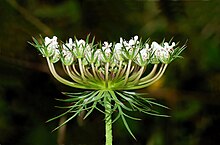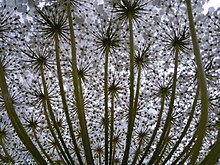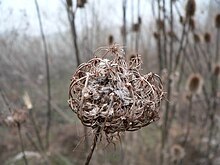bio.wikisort.org - Plant
Daucus carota, whose common names include wild carrot, European wild carrot, bird's nest, bishop's lace, and Queen Anne's lace (North America), is a flowering plant in the family Apiaceae. It is native to temperate regions of the Old World and was naturalized in the New World.
| Wild carrot | |
|---|---|
 | |
| The umbel of a wild carrot | |
Conservation status | |
| Scientific classification | |
| Kingdom: | Plantae |
| Clade: | Tracheophytes |
| Clade: | Angiosperms |
| Clade: | Eudicots |
| Clade: | Asterids |
| Order: | Apiales |
| Family: | Apiaceae |
| Genus: | Daucus |
| Species: | D. carota |
| Binomial name | |
| Daucus carota | |
| Synonyms[2] | |
|
List
| |
Domesticated carrots are cultivars of a subspecies, Daucus carota subsp. sativus.
Description



The wild carrot is a herbaceous, somewhat variable biennial plant that grows between 30 and 120 cm (1 and 4 ft) tall,[3][4] and is roughly hairy, with a stiff, solid stem. The leaves are tripinnate, finely divided and lacy, and overall triangular in shape. The leaves are 5–15 cm (2–6 in) long,[4] bristly and alternate in a pinnate pattern that separates into thin segments. The flowers are small and dull white, clustered in flat, dense umbels. The umbels are terminal and about 8–15 cm (3–6 in) wide.[5][4] They may be pink in bud and may have a reddish or purple[6] flower in the centre of the umbel. The lower bracts are three-forked or pinnate, which distinguishes the plant from other white-flowered umbellifers. As the seeds develop, the umbel curls up at the edges, becomes more congested, and develops a concave surface. The fruits are small, dry, bumpy, oval and flattened, with short styles and hooked spines, as well as protective hairs surrounding it.[7][5] The fruit has two mericarps, or bicarpellate. The endosperm of the fruit grows before the embryo.[8] The dried umbels detach from the plant, becoming tumbleweeds.[9] The function of the tiny red flower, coloured by anthocyanin, is to attract insects. The flowers bloom from May to September.[5][4]
Similar in appearance to the deadly poison hemlock, D. carota is distinguished by a mix of tripinnate leaves, fine hairs on its solid green stems and on its leaves, a root that smells like carrots, and occasionally a single dark red flower in the center of the umbel.[10][11] Hemlock is also different in tending to have purple mottling on its stems, which also lack the hairiness of the plain green Queen Anne's lace (wild carrot) stems.[12] Both plants have been spread into North America by European settlers and are now common wildflowers there.
Function of the dark central florets
The function of the central dark florets of D. carota has been subject to debate since Charles Darwin speculated that they are a vestigial trait.[13] It has been suggested that they have the adaptive function of mimicking insects, thus either discouraging herbivory,[14] or attracting pollinators[15] by indicating the presence of food or opportunities for mating.[16] One study in Portugal found that the dark florets contributed to visitation by the varied carpet beetle, Anthrenus verbasci, and that higher numbers of dark florets correlated with increased visitation, whereas inflorescences without dark florets had fewer visits. Replacing the dark florets with one or more freeze-killed A. verbasci, who are similar to the florets in size and shape produced similar results to those observations of inflorescences with intact florets.[17]
Taxonomy
The carrot was first officially described by Carl Linnaeus in his 1753 work Species Plantarum.[18] In 2016, an international team sequenced the full genome of Daucus carota.[19]
Subspecies
Cultivated carrot's only parent is Daucus carota.[20]
Both domestic and wild carrot are from the same species, Daucus carota L. There are several subspecies of D. carota that have evolved to different climates and atmospheres. Two examples of these subspecies are specifically from the Netherlands. D. carota subsp. sativus has roots that can be a wide range of colors. It has a thicker root and sweeter taste. The whorl of barbs above the spine on the vallecular ridges of the mericarp of D. carota subsp. sativus mature very well.[clarification needed] D. carota subsp. carota has white roots that do not vary in color and, unlike D. carota subsp. sativus, has a thin root, bitter taste and are not edible. The middle umbellet of D. carota subsp. carota is not well developed (unlike in D. carota subsp. sativus) and the color of the flower can vary from red to deep purple.[21]
Subtaxa
The following subtaxa are accepted:[2]
- Daucus carota var. abyssinicus A.Braun
- Daucus carota subsp. annuus (Bég.) Mart.Flores, D.M.Spooner & M.B.Crespo
- Daucus carota subsp. azoricus Franco
- Daucus carota subsp. cantabricus A.Pujadas
- Daucus carota subsp. capillifolius (Gilli) Arbizu
- Daucus carota subsp. caporientalis Reduron
- Daucus carota subsp. carota
- Daucus carota subsp. commutatus (Paol.) Thell.
- Daucus carota subsp. corsoccidentalis Reduron
- Daucus carota subsp. drepanensis (Arcang.) Heywood
- Daucus carota subsp. fontanesii Thell.
- Daucus carota subsp. gadecaei (Rouy & E.G.Camus) Heywood
- Daucus carota subsp. gummifer (Syme) Hook.f.
- Daucus carota subsp. halophilus (Brot.) A.Pujadas
- Daucus carota subsp. hispanicus (Gouan) Thell.
- Daucus carota subsp. major (Vis.) Arcang.
- Daucus carota subsp. majoricus A.Pujadas
- Daucus carota subsp. maritimus (Lam.) Batt.
- Daucus carota subsp. maximus (Desf.) Ball
- Daucus carota var. meriensis Reduron
- Daucus carota subsp. otaportensis Reduron
- Daucus carota subsp. rupestris (Guss.) Heywood
- Daucus carota subsp. sativus (Hoffm.) Schübl. & G.Martens
- Daucus carota subsp. tenuissimus (A.Chev.) Mart.Flores, D.M.Spooner & M.B.Crespo
- Daucus carota subsp. valeriae Reduron
Distribution and habitat
Native to temperate regions of Europe[4] and southwest Asia, the plant was spread to North America and Australia.
The plant is commonly found along roadsides and in unused fields. It thrives best in sun to partial shade.[5]
Toxicity
Skin contact with the foliage of Daucus carota, especially wet foliage, can cause skin irritation in some people.[22][23] It may also have a mild effect on horses.[24]
The compound falcarinol is naturally found in Daucus carota for protection against fungal diseases. Lab tests show the compound to be toxic to mice and the water flea Daphnia magna.[25] Normal consumption of carrots has no toxic effect in humans.[26]
Uses
Like the cultivated carrot, the D. carota root is edible while young, but it quickly becomes too woody to consume.[citation needed] The flowers are sometimes battered and fried. The leaves and seeds are also edible.[5]
D. carota bears a close resemblance to poison hemlock, and the leaves of the wild carrot may cause phytophotodermatitis,[27][23] so caution should also be used when handling the plant. The seeds and flowers have been used as a method of contraception and an abortifacient for centuries.[28][29][30] If used as a dyestuff, the flowers give a creamy, off-white color.
D. carota, when freshly cut, will draw or change color depending on the color of the water in which it is held. This effect is only visible on the "head" or flower of the plant. Carnations also exhibit this effect. This occurrence is a popular science demonstration in grade school.
Beneficial weed
This beneficial weed can be used as a companion plant to crops. Like most members of the umbellifer family, it attracts wasps to its small flowers in its native land; however, where it has been introduced, it attracts very few wasps. In northeast Wisconsin, when introduced with blueberries it did succeed in attracting butterflies and wasps.[31] This species is also documented to boost tomato plant production when kept nearby, and it can provide a microclimate of cooler, moister air for lettuce, when intercropped with it.[32] However, the states of Iowa, Michigan, and Washington have listed it as a noxious weed,[33] and it is considered a serious pest in pastures. It persists in the soil seed bank for two to five years.[34]
Taste
Several different factors can cause the root of a carrot to have abnormal metabolites (notably 6-methoxymellin) that can cause a bitter taste in the roots. For example, carrots have a bitterer taste when grown in the presence of apples. Also, ethylene can easily produce stress, causing a bitter taste.[35]
Culture
Daucus carota was introduced and naturalized in North America, where it is often known as Queen Anne's lace. Both Anne, Queen of Great Britain, and her great-grandmother, Anne of Denmark, are taken to be the Queen Anne for whom the plant is named.[36] It is so called because the flower resembles lace, prominent in fine clothing of the day; the red flower in the center is said to represent a droplet of blood where Queen Anne pricked herself with a needle when she was making the lace.
History through artwork
The history of Daucus carota and its cultivation in different parts of the world can be traced back through historical texts and artwork. Paintings from the 16th and 17th century, for example, that are of maids in a market or farmers' most recent crops can provide information on carrots' history. Studying such paintings shows that yellow or red roots were cultivated in Turkey, North Africa, and Spain. Orange roots were cultivated in 17th century Netherlands.[37]
References in poetry
Queen Anne's Lace is the title and subject of a poem by William Carlos Williams published in the 1921 collection titled Sour Grapes.
See also
- Daucus pusillus, American wild carrot
References
- Collett, L., Korpelainen, H., Draper Munt, D., Labokas, J., Magos Brehm, J., Tavares, M., Eliáš, P., Strajeru, S., Smekalova, T. & Bulińska, Z. 2011. Daucus carota. The IUCN Red List of Threatened Species 2011: e.T172210A6849906. Downloaded on 02 July 2021.
- "Daucus carota L." Plants of the World Online. Royal Botanic Gardens, Kew. Retrieved March 20, 2022.
- Ontario Weeds: Wild carrot
- Spellenberg, Richard (2001) [1979]. National Audubon Society Field Guide to North American Wildflowers: Western Region (rev ed.). Knopf. p. 338. ISBN 978-0-375-40233-3.
- "Daucus carota". plants.ces.ncsu.edu. Retrieved March 31, 2017.
- A field guide to wildflowers: northeastern and north-central North America, Peterson, Roger Tory, and Margaret McKenny. Houghton Mifflin Harcourt, 1968. p. 48 Retrieved on 27 March 2017.
- McClintock, David; Fitter, R. S. R. (1956). The Pocket Guide to Wild Flowers. Collins. p. 103.
- Wurtele, E S; Wang, H; Durgerian, S; Nikolau, B J; Ulrich, T H (May 1993). "Characterization of a gene that is expressed early in somatic embryogenesis of Daucus carota". Plant Physiology. 102 (1): 303–312. doi:10.1104/pp.102.1.303. PMC 158776. PMID 8108498.
- Faulkner, Herbert Waldron (1917). The Mysteries of the Flowers. Frederick A. Stokes. p. 210.
- Noxious weeds: Poison-hemlock, King County, Washington
- Hemlock Poisoning at eMedicine
- Garms, Gabe. "How to Tell the Difference Between Poison Hemlock and Queen Anne's Lace". Raven's Roots.
- Darwin, Charles. The Different Forms of Flowers on Plants of the Same Species. --. London: JMurray, 1877.
- Detto, C. “Blutenbiologische Untersuchungen, I. Uber Die Beteutung Der Insektenahnlichkeit Der Ophrysblute Nebst Bemerkungen Uber Die Mohrenblute Dei Daucus Carota.” Flora, Jena 94 (1905): 287–329.
- Rothschild, M. “Some Observations on the Relationship between Plants, Toxic Insects and Birds.” In Phytochemical Ecology, edited by J.B. Harborne, 1–12. London: Academic Press, 1972.
- Yeo, P.F. (December 1972). "Miscellaneous notes on pollination and pollinators". Journal of Natural History. 6 (6): 667–686. doi:10.1080/00222937200770621.
- Goulson, David; Mcguire, Kate; Munro, Emma E.; Adamson, Susan; Colliar, Louise; Park, Kirsty J.; Tinsley, Matthew C.; Gilburn, Andre S. (August 2009). "Functional significance of the dark central floret of Daucus carota (Apiaceae) L.; is it an insect mimic?". Plant Species Biology. 24 (2): 77–82. doi:10.1111/j.1442-1984.2009.00240.x.
- Linnaeus, Carolus (1753). Species Plantarum (in Latin). Vol. 1. Stockholm: Laurentii Salvii. p. 242.
- "Carrot Genome Sequenced". May 9, 2016.
- Banga, O. (February 1957). "Origin of the European cultivated carrot". Euphytica. 6 (1): 54–63. doi:10.1007/BF00179518. S2CID 39884390.
- Baranski, Rafal; Maksylewicz-Kaul, Anna; Nothnagel, Thomas; Cavagnaro, Pablo F.; Simon, Philipp W.; Grzebelus, Dariusz (February 2012). "Genetic diversity of carrot (Daucus carota L.) cultivars revealed by analysis of SSR loci". Genetic Resources and Crop Evolution. 59 (2): 163–170. doi:10.1007/s10722-011-9777-3.
- "Daucus carota". www.hort.purdue.edu. Retrieved April 21, 2017.
- "Don't touch these plants! Six lookalikes you want to avoid". U.S. Fish & Wildlife Service. July 19, 2017. Retrieved September 8, 2018.
- LLC, HorseDVM. "Queen anne's lace Poisoning in Horses". HorseDVM.
- Crosby, D.G.; Aharonson, N. (January 1967). "The structure of carotatoxin, a natural toxicant from carrot". Tetrahedron. 23 (1): 465–472. doi:10.1016/S0040-4020(01)83330-5. PMID 6037290.
- Deshpande (2002). Handbook of Food Toxicology. Hyderabad, India: CRC Press. ISBN 978-0-8247-0760-6.
- Phytophotodermatitis~clinical at eMedicine
- Jansen, Gabrielle Claire; Wohlmuth, Hans (January 2014). "Carrot seed for contraception: A review". Australian Journal of Herbal Medicine. 26 (1): 10–17.
- Contraception and Abortion from the Ancient World to the Renaissance, John M. Riddle, pg 58.
- Peters, Emily (December 2014). "Wild Carrot Monograph" (PDF). Ember Peters, RHP Wild Current Herbalism. Retrieved August 11, 2020.
- Laurie Neverman (June 24, 2017). Queen Anne's Lace - Butterfly Host Plant and Blueberry Protector.
- Philbrick H.; Gregg R. B. Companion Plants.
- USDA PLANTS. PLANTS Profile for Daucus carota (Queen Anne's lace. Retrieved June 11, 2007.
- Clark, D. L.; Wilson, M. V. (May 1, 2003). "Post-dispersal seed fates of four prairie species". American Journal of Botany. 90 (5): 730–735. doi:10.3732/ajb.90.5.730. PMID 21659169.
- Coxon, David T.; Curtis, R.Frank; Price, Keith R.; Levett, Gordon (August 1973). "Abnormal metabolites produced by Daucus carota roots stored under conditions of stress". Phytochemistry. 12 (8): 1881–1885. doi:10.1016/S0031-9422(00)91505-X.
- "Queen Ann's Lace". Archived from the original on June 21, 2012. Retrieved November 10, 2012.
- Zeven, A. C.; Brandenburg, W. A. (October 1986). "Use of paintings from the 16th to 19th centuries to study the history of domesticated plants". Economic Botany. 40 (4): 397–408. doi:10.1007/BF02859650. S2CID 24391862.
Further reading
- Blanchan, Neltje (2005). Wild Flowers Worth Knowing. Project Gutenberg Literary Archive Foundation.
- Bradeen, James M.; Simon, Philipp W. (2007). "Carrot". In Cole, Chittaranjan (ed.). Vegetables. Genome Mapping and Molecular Breeding in Plants. Vol. 5. New York, New York: Springer. pp. 162–184. ISBN 978-3-540-34535-0.
- Clapham, A. R.; Tutin, T. G.; Warburg, E. F. (1962). Flora of the British Isles. Cambridge University Press.
- Mabey, Richard (1997). Flora Britannica. London: Chatto and Windus.
- Rose, Francis (2006). The Wild Flower Key (edition revised and expanded by Clare O'Reilly). London: Frederick Warne. ISBN 978-0-7232-5175-0.
- Rubatsky, V.E.; Quiros, C.F.; Siman, P.W. (1999). Carrots and Related Vegetable Umbelliferae. CABI Publishing. ISBN 978-0-85199-129-0.
External links
На других языках
- [en] Daucus carota
[es] Daucus carota
Daucus carota sativus, llamada popularmente zanahoria, es la forma domesticada de la zanahoria silvestre (Daucus carota), especie de la familia de las umbelíferas, también denominadas apiáceas, y considerada la más importante y de mayor consumo dentro de esta familia. Es oriunda de Europa y Asia sudoccidental. Se cultiva por su raíz mucho más grande, sabrosa y de textura menos fibrosa que la especie silvestre.[it] Daucus carota
La carota (Daucus carota L., 1753) è una pianta erbacea dal fusto di colore verde appartenente alla famiglia delle Apiaceae; è anche uno dei più comuni ortaggi, e il suo nome deriva dal latino tardo carōta, a sua volta dal gr. καρωτόν (karōton). La carota spontanea è diffusa in Europa, in Asia e nel Nord Africa. Ne esistono molte e diverse cultivar che sono coltivate in tutte le aree temperate del globo. Allo stato spontaneo è considerata pianta infestante e si trova facilmente in posti assolati ed in zone calde e sassose.[ru] Морковь дикая
Морко́вь ди́кая, или Морковь обыкнове́нная (лат. Dáucus caróta) — двулетнее, реже однолетнее травянистое растение, вид рода Морковь (Daucus) семейства Зонтичные.Другой контент может иметь иную лицензию. Перед использованием материалов сайта WikiSort.org внимательно изучите правила лицензирования конкретных элементов наполнения сайта.
WikiSort.org - проект по пересортировке и дополнению контента Википедии
